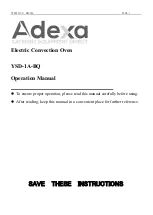
8
Owner's Manual for
DUKE RCO Speed Oven
Unpacking Oven
•
Inspect the oven for damage such as dents in
the door or inside the oven cavity.
•
Report any dents or breakage to source of
purchase immediately.
Do not attempt to use
oven if it is damaged.
•
Remove all materials from oven interior.
•
If oven has been stored in an extremely cold
area, wait a few hours before connecting power.
Radio Interference
Microwave operation may cause interference
to radio, television or a similar oven. Reduce or
eliminate interference by taking the following
precautions:
•
Clean the door and sealing surfaces of the oven
according to the instructions in the CARE AND
CLEANING section.
•
Place radios, televisions and similar electronic
devices as far as possible from the oven.
•
Use a properly installed antenna on radio,
television and similar electronic devices to obtain
stronger signal reception.
Oven Placement
•
Do not install oven adjacent to a source of heat
such as pizza oven or deep fat fryer. This could
cause the microwave oven to operate improperly
and shorten the life of electrical parts.
•
Install the oven on a level countertop surface.
•
If provided, place warning label in an obvious
place close to the microwave oven.
•
The outlet should be located so that the plug is
accessible when the oven is in place.
WARNING
RISK OF APPLIANCE FALLING.
RISK OF PERSONAL INJURY
ONLY operate appliance if its legs are in direct
contact with the countertop or supporting
surface. If the legs are not in direct contact
with the supporting surface, the appliance can
creep slowly during repeated use, eventually
falling off the surface when the door is opened.
Such a fall could possibly injure anyone nearby.
The appliance is often installed using sliding
pads which are inserted between its legs and
supporting surface. These sliding pads MUST
be removed before operating the oven. Nothing
else should be inserted between the legs and the
supporting surface.
Oven Clearances
•
Allow at least 6 in. (15.2 cm) of clearance on top.
•
No clearance is required at the back.
•
A clearance of 0.5 in. (1.3 cm) is necessary
between side panels and adjacent walls.
•
A clearance of 3 in. (7.6 cm) is required to
operate two ovens side by side or the clearance
to an adjacent similar heat source.
•
Proper airflow around the oven cools electrical
components. With restricted airflow, the oven
may not operate properly and life of the electrical
parts is reduced.
•
Install the oven so the oven bottom is at least 36
in. (93.0 cm) above the floor.
•
When stacking ovens, ONLY use the Duke
stacking frame.
Line Interference
The switching operation of this microwave oven
can cause voltage fluctuations on the supply line.
The operation of this oven under unfavorable
voltage supply conditions can have adverse effects.
This device is intended for connection to a power
supply system with maximum permissible system
impedance, Z
max
, of 1.1Ω at the interface point of
the user’s supply. The user has to ensure that this
device is connected only to a power supply system
which fulfills this requirement. If necessary, the
user can ask the public power supply company
for the system impedance at the interface point.
As the oven has no ON/OFF switch, it must be
connected to a breaker that conforms to national
regulations.
WARNING
To avoid risk of electrical shock or death, this
oven must be grounded and the plug must not
be altered. Improper grounding can result in
electrical shock.
INSTALLATION INSTRUCTIONS









































